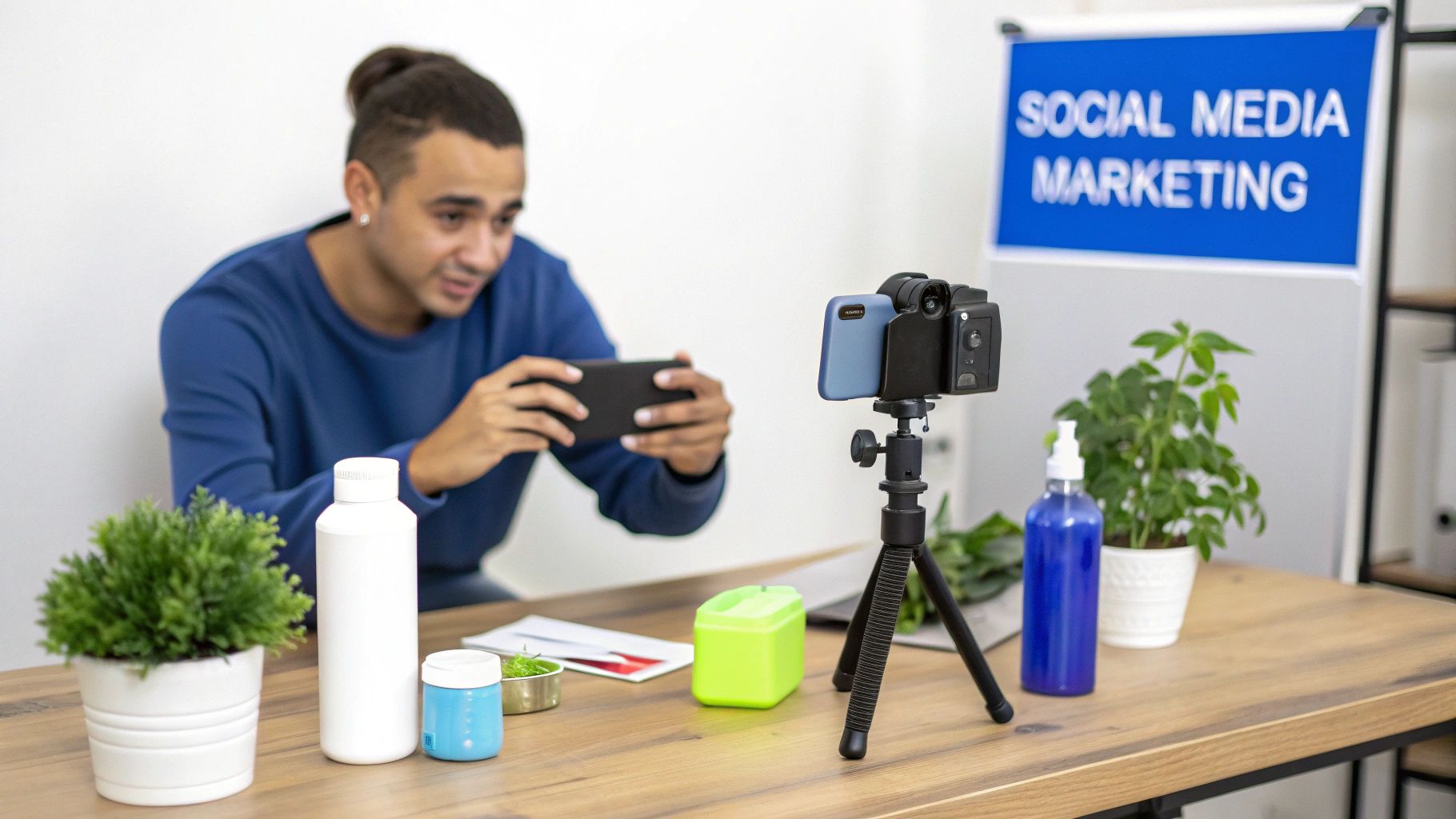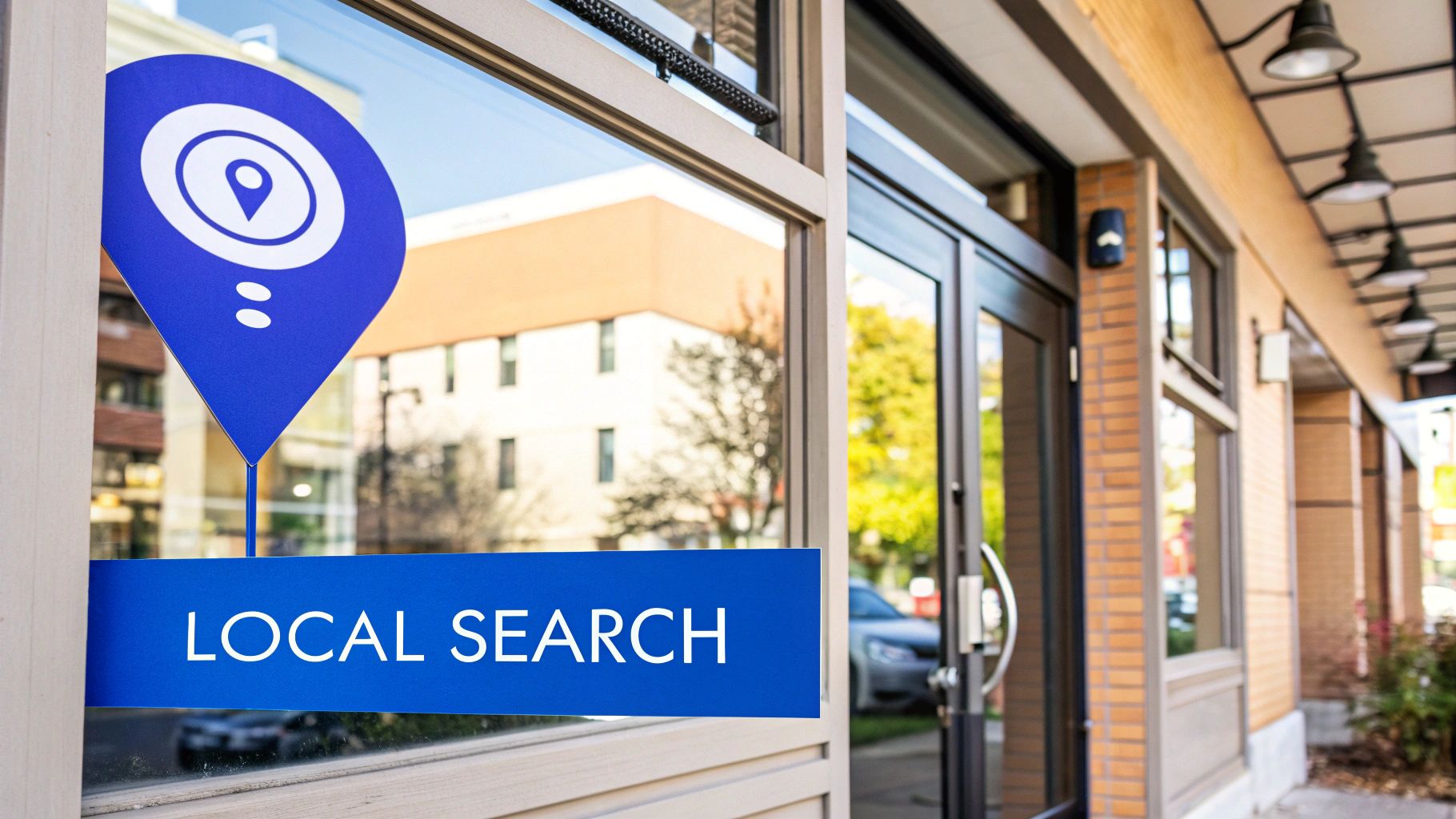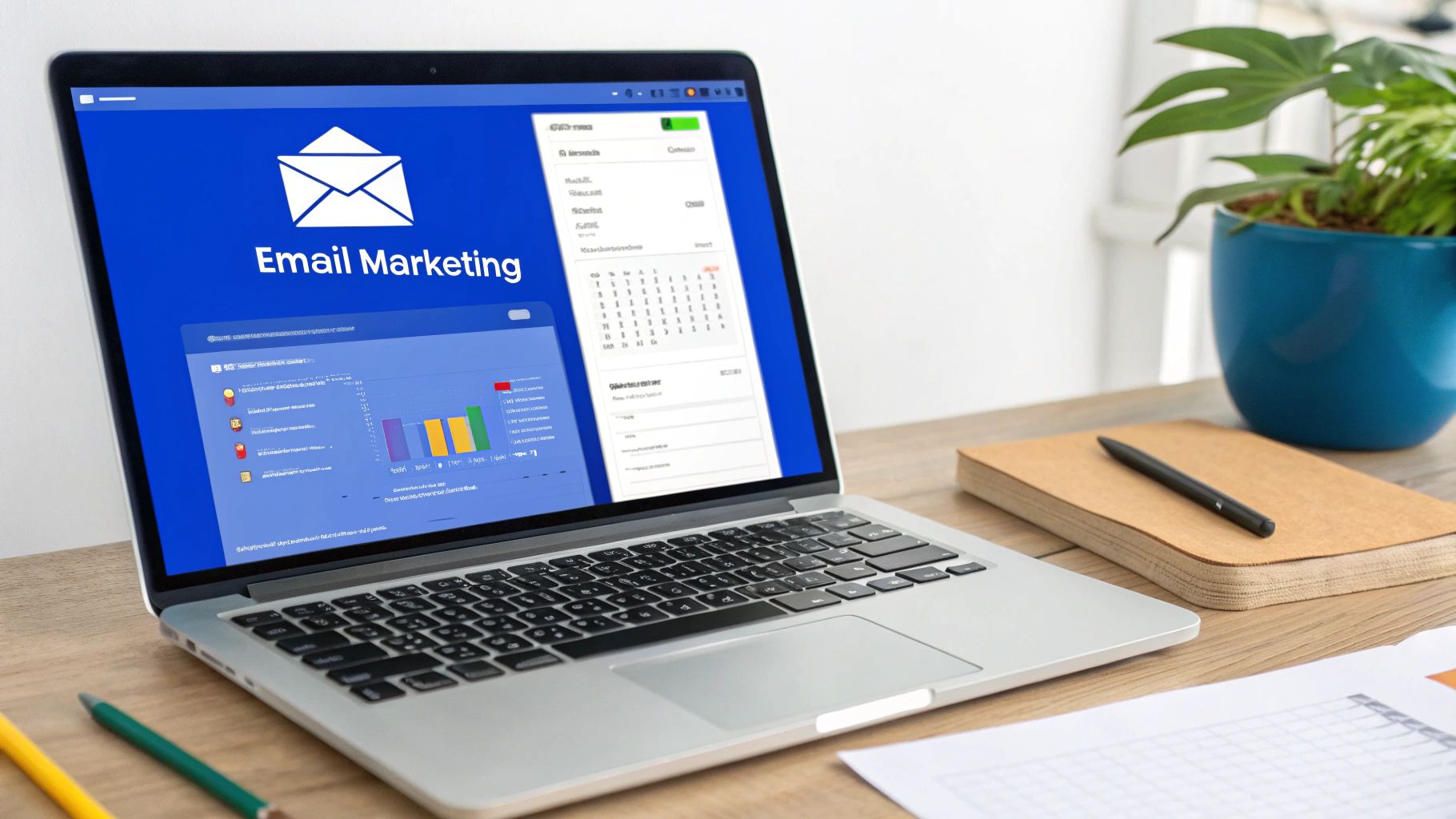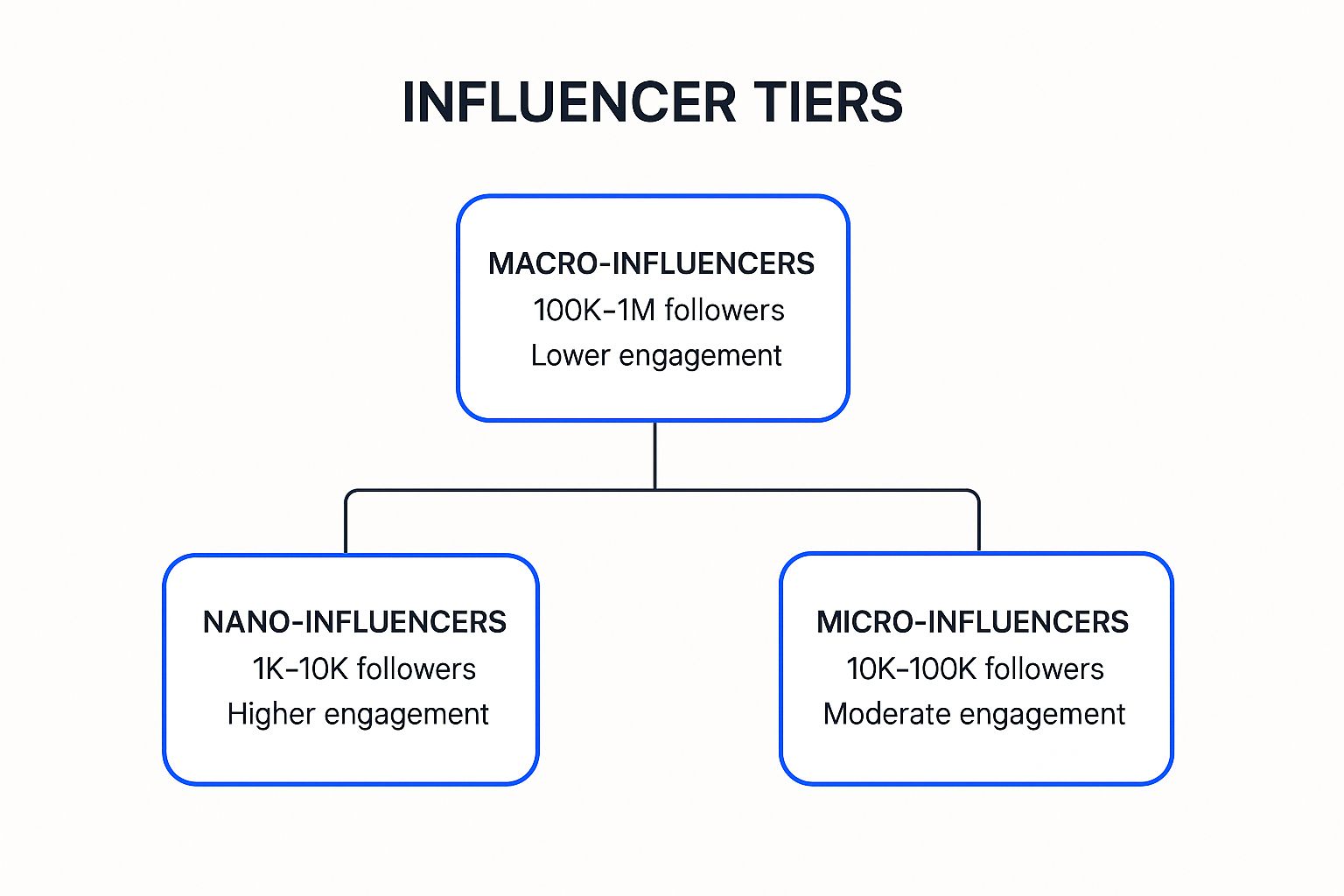When you're running a small business, you need advertising that works without breaking the bank. The challenge isn't a lack of options—it's finding straightforward ideas that get real results. This guide cuts through the noise to give you practical advertising strategies you can start using today, blending smart digital tactics with proven traditional methods.
We’ll skip the vague advice and jump straight into actionable steps. From making sure local customers can find you with Google My Business to launching clever, low-cost marketing campaigns, each idea is designed for maximum impact. You'll learn how to build brand awareness, connect with your community, and grow your business sustainably. To make sure your efforts are paying off, it’s smart to use data analytics for small businesses. This helps you see what's working so you can do more of it. Let's get started.
1. Social Media Marketing
Social media marketing means using platforms like Facebook, Instagram, and TikTok to connect with your customers. It's more than just posting; it's about building a community around your brand by sharing useful content, talking with your followers, and running targeted ads. For a small business, it’s a cost-effective way to build brand awareness, drive traffic to your website, and find new customers.

Think of a local restaurant posting daily specials on Instagram with delicious-looking photos, or a freelance graphic designer sharing tips and client work on LinkedIn. The key is to create content that your ideal customer finds interesting and helpful.
How to Implement This Strategy
To get started, focus on being consistent and authentic. A simple content plan helps you post regularly, and responding to comments and messages shows you care. For businesses in the beauty or service industry, a solid social media plan is a must. If you need a detailed plan, check out this actionable guide to social media marketing for beauty salons.
- Choose the Right Platforms: Don't try to be everywhere. Pick one or two platforms where your target customers hang out the most.
- Create a Content Calendar: Plan your posts ahead of time. This keeps you consistent and saves you from scrambling for ideas.
- Engage Authentically: When people comment, reply! Ask questions in your posts to start conversations.
- Use Platform-Specific Features: Try out Instagram Reels, Facebook Stories, or short TikTok videos. They're great for getting more eyes on your content.
- Test and Analyze: Use the platform’s free analytics to see what’s working. Pay attention to what posts get the most engagement and adjust your plan based on what you learn.
2. Google My Business Optimization
Google Business Profile (formerly Google My Business) is a free tool that helps you show up in Google Search and on Google Maps. For any small business that serves local customers, this is non-negotiable. When your profile is set up correctly, you’ll appear in the "Local Pack" when people search for services near them, bringing customers directly to you without any ad spend.

This strategy works because it catches customers right when they’re ready to buy. A local bakery with a complete profile, great reviews, and photos of its pastries is more likely to get a visit than a competitor with an empty profile. It's one of the most direct and effective advertising ideas for small businesses.
How to Implement This Strategy
A complete and active profile tells Google that your business is legitimate and relevant. Your goal is to fill it out completely and keep it updated. This improves your ranking and gives customers the information they need to choose you.
- Complete Your Profile 100%: Fill out every single section: services, hours, address, phone number, and a business description that includes your keywords.
- Encourage and Respond to Reviews: Ask happy customers to leave a review. Make sure to reply to all of them—good and bad. It shows you're engaged.
- Upload High-Quality Photos: Regularly add pictures of your storefront, products, team, and happy customers. This builds trust and shows what you're all about.
- Use Google Posts: Share updates, special offers, events, or new products. These posts show up directly on your profile and keep it looking fresh.
- Enable Messaging: Let customers message you directly from your profile. It's an easy way for them to ask questions and a simple way for you to get new leads.
3. Content Marketing
Content marketing is all about creating and sharing helpful information—like blog posts, videos, or guides—to attract customers naturally. Instead of a hard sell, you're offering value and solving problems. This builds trust and positions your business as an expert in your field, making it one of the best long-term advertising ideas for small businesses.
For example, a financial advisor could write blog posts about saving for retirement to attract clients, or a landscaping company could create short videos on how to care for different types of plants. You provide useful information first, which builds a loyal audience that is more likely to buy from you later.
How to Implement This Strategy
The key to good content marketing is consistency and a focus on your audience's needs. It's not just about writing; it involves planning, creating, sharing, and analyzing to make sure your efforts are paying off. If you need a more detailed roadmap, this expert’s guide to content marketing strategy can walk you through the process.
- Focus on Solving Problems: Figure out what your customers' biggest questions are and create content that answers them.
- Create a Content Calendar: Plan what you're going to publish and when. This helps you stay consistent and cover a range of topics.
- Repurpose Content: Get more mileage out of your work. Turn a blog post into an infographic, a short video, or a series of social media posts.
- Optimize for Search Engines (SEO): Use keywords that your customers are searching for. This helps your content show up on Google.
- Engage with Your Audience: Encourage comments and discussions on your content. Responding to them helps build a community.
4. Email Marketing
Email marketing is a way to send targeted messages directly to people who have shown interest in your business. You can use it to nurture leads, announce sales, or simply stay in touch. Even with all the new platforms out there, email remains one of the most effective advertising ideas for small businesses because it gives you a direct line to your audience and a great return on investment.

For example, an online store can send an automatic email reminder to customers who left items in their cart. A local yoga studio could send a weekly newsletter with class schedules and wellness tips. It's all about sending the right message to the right people at the right time.
How to Implement This Strategy
Good email marketing is about providing value, not just spamming people with sales pitches. The first step is to build your email list by offering something useful in exchange for an email address, like a discount or a free guide. This ensures you're talking to people who actually want to hear from you.
- Build Your List Organically: Offer a "lead magnet," like a free checklist, e-book, or coupon, to get people to sign up.
- Segment Your Audience: Group your subscribers based on their interests or what they've bought before. This lets you send more personalized and relevant emails.
- Write Compelling Subject Lines: Your subject line is what gets your email opened. Keep it short, interesting, and to the point.
- Optimize for Mobile: Most people read emails on their phones. Make sure your emails look good and are easy to read on a small screen.
- Test and Analyze: Pay attention to your open rates and click-through rates. This data tells you what your audience likes so you can improve your next email.
5. Referral Programs
A referral program is a system that encourages your current customers to recommend your business to their friends and family. By offering a reward for each new customer they bring in, you turn your happiest clients into a team of enthusiastic salespeople. This is one of the most powerful and low-cost advertising ideas for small businesses because it's built on trust.
Dropbox famously grew by giving free storage space to both the person referring and the new user. On a smaller scale, a local dog groomer could offer a discount on the next visit for every new client referred. It's a win-win that drives growth based on real customer satisfaction.
How to Implement This Strategy
A great referral program needs to be simple, valuable, and easy to find. The goal is to make it as easy as possible for people to share. While different from affiliate marketing, both use incentives to drive promotion. You can learn more about why this works by exploring the key reasons to start a marketing program.
- Make It Simple: The process should be dead simple. A unique link or a simple form is all you need.
- Offer Valuable Rewards: The reward has to be good enough to motivate people. Think discounts, free products, or cash.
- Promote the Program: Let your customers know about it! Mention it in your emails, on your website, and on social media.
- Track and Measure: Keep track of who is referring new customers. This helps you see how well the program is working.
- Show Appreciation: Always thank your customers for their referrals. A little gratitude goes a long way.
6. Local SEO and Directory Listings
Local SEO (Search Engine Optimization) is all about making your business more visible in local search results. The goal is to show up when people in your area search for the products or services you offer. By making sure your business information is correct and consistent online, you can attract customers who are actively looking to buy right now.
For example, a coffee shop that appears at the top of Google Maps for "coffee near me" is going to get more foot traffic. A plumber who ranks for "emergency plumber in [your city]" will get calls from people who need help immediately. For any business with a physical location, this is a must-do.
How to Implement This Strategy
The foundation of good local SEO is a complete and optimized Google Business Profile. From there, it's about making sure your business information is consistent everywhere online. This builds trust with both Google and your potential customers.
- Claim and Optimize Your Google Business Profile: This is your first and most important step. Fill out every section and add good photos.
- Ensure NAP Consistency: Your Name, Address, and Phone number (NAP) need to be exactly the same everywhere online, from your website to Yelp.
- Build Local Citations: Get your business listed in important online directories like Yelp, TripAdvisor, and any that are specific to your industry.
- Encourage and Respond to Reviews: Good reviews are a huge factor in local search rankings. Ask happy customers to leave a review and always respond to feedback.
- Create Location-Specific Content: If you serve multiple areas, create pages on your website for each location. Use local keywords to help people find you.
7. Influencer Partnerships
Influencer partnerships are when you team up with people who have a dedicated following on social media. This allows your business to reach a new audience through a trusted source. Instead of a typical ad, it feels more like a genuine recommendation from a friend, which can be very effective.
A small clothing boutique might partner with a local fashion blogger to showcase a new collection. A new restaurant could invite food influencers for a tasting event. The key is finding an influencer whose followers match your target customers.
How to Implement This Strategy
Start by looking for influencers who are a good fit for your brand, not just the ones with the most followers. A genuine connection is more important than a huge audience. For small businesses, micro-influencers are often the best place to start because they have high engagement and are more affordable.
This infographic shows the different types of influencers, which can help you decide where to focus your efforts.

As you can see, nano and micro-influencers often get better engagement, making them a smart choice for small businesses wanting real results.
- Start with Micro-Influencers: Look for creators with 1,000 to 100,000 followers. Their audiences are often very engaged, and they're more affordable.
- Establish Clear Expectations: Agree on what they will deliver, what your key messages are, and how they will be compensated. But give them creative freedom to be authentic.
- Prioritize Audience Alignment: Make sure the influencer's followers are actually your ideal customers.
- Track Key Performance Metrics: Go beyond likes. Track things like link clicks or the use of a unique discount code to measure your return on investment.
8. Guerrilla Marketing
Guerrilla marketing uses surprise and creativity to get people talking about your brand. Instead of a big budget, it relies on imagination and unconventional tactics to create a memorable experience. For a small business, it's a great way to stand out from bigger competitors by being clever and unexpected.
Think of a local ice cream shop using chalk art on the sidewalk to create a fun path to their door, or a bookstore organizing a "flash mob" of people reading in a public park. The goal is to make people stop, smile, and share what they saw.
How to Implement This Strategy
Successful guerrilla marketing comes from knowing your audience and being bold. The campaign should feel authentic to your brand and create a genuine surprise for the public. It works best when it feels natural and is designed to be shared online.
- Brainstorm Unconventional Ideas: Think about where your customers spend their time and how you can surprise them in their daily routine.
- Consider Legal and Safety: Always check local rules before doing anything in public. Make sure your idea is safe for everyone involved.
- Plan for Documentation: The real magic happens when people share it online. Have someone ready to take high-quality photos and videos to post on social media.
- Align with Brand Values: The stunt has to make sense for your brand. A funny campaign might work for a toy store but not for a law firm.
- Be Prepared for Any Reaction: Because this type of marketing is unpredictable, be ready for all kinds of responses from the public.
9. Community Engagement and Local Partnerships
Community engagement is about becoming an active and trusted part of your local area. This means participating in local events, sponsoring teams, and partnering with other non-competing businesses. By showing you care about your community, you build strong, authentic connections that lead to word-of-mouth marketing and loyal customers.
For example, a local cafe could provide free coffee at a charity run, or a hardware store could partner with a real estate agent to offer a "new homeowner" discount package. These actions show you're invested in the community, which local customers appreciate.
How to Implement This Strategy
The key here is authenticity. Your efforts should feel genuine, not just like a marketing ploy. Start by finding local events or businesses that align with your brand's values. For more ideas on this approach, this guide to community marketing provides some great tips.
- Identify Synergistic Partnerships: Find businesses that serve the same customers but don't compete with you. A pet store could team up with a local dog walker, for example.
- Be Genuinely Involved: Don’t just write a check. Show up to events and volunteer. Real involvement builds real relationships.
- Create Mutually Beneficial Offers: Make sure any partnership benefits both businesses. This could be a joint promotion or reciprocal discounts.
- Promote Your Involvement: Share what you're doing in the community on social media. It shows customers you care and encourages them to support you.
- Join Local Business Groups: Get involved with your local Chamber of Commerce or other business groups to network and find new partnership opportunities.
Advertising Ideas Strategy Comparison Table
Your Next Step: Choosing the Right Advertising Mix
Looking at all these advertising ideas for small businesses can feel like a lot. We've covered everything from dominating local search with Google My Business to building a loyal following with email marketing. The goal isn't to overwhelm you but to show you what's possible.
The most important thing to remember is that there's no single "best" strategy. Success comes from creating a mix of ideas that fits your specific goals, audience, and budget. A local restaurant might focus on its Google Business Profile, community events, and Instagram. An online store, on the other hand, might prioritize influencer partnerships and email marketing. The key is to use multiple channels that work together.
Crafting Your Initial Strategy
So, where should you start? The trick is to start small, be consistent, and measure your results. Don't try to do everything at once. Instead, follow these simple steps:
- Audit Your Resources: Be honest about how much time and money you have. Content marketing takes more time, while paid ads take more money.
- Select Your "Power Trio": Pick two or three ideas from this list that seem most doable and relevant for you right now. Choose them based on where your ideal customers spend their time.
- Set Clear, Measurable Goals: Decide what success looks like. Is it 10 new leads from local search? A 20% increase in website traffic from social media? Clear goals give you a clear direction.
- Execute and Track: Stick with your chosen strategies for at least a few months. Use analytics tools to track your progress. This data will tell you what's working and what to do next.
The Power of Iteration and Growth
Think of your advertising plan as a living thing. It should change and grow as your business does. The first few strategies you choose are just your starting point. As you get better at them, you can add new tactics and move your budget to what works best. The goal is to build a reliable system that consistently brings in new customers. By testing, learning, and adapting, you turn advertising from an expense into your most powerful tool for growth.
Frequently Asked Questions (FAQ)
Q: What are the most effective advertising ideas for a small business with a very limited budget?
A: For a tight budget, focus on high-impact, low-cost strategies. Optimizing your Google Business Profile is completely free and drives local traffic. Basic social media marketing, where you focus on engaging with your community, and starting a simple email newsletter are also extremely cost-effective. These methods rely more on your time and creativity than your money.
Q: How do I know which advertising ideas are right for my specific business?
A: The best ideas depend on your target audience. Ask yourself: "Where do my ideal customers spend their time?" If you run a B2B service, LinkedIn and content marketing might be best. If you own a visual brand like a bakery or clothing store, Instagram and Pinterest are great choices. For any local business, Google Business Profile and local SEO are essential.
Q: How long does it take to see results from these advertising ideas?
A: It varies. You can see results from Google Business Profile optimization and local ads relatively quickly (within weeks). Strategies like content marketing and SEO are more of a long-term investment; it can take 3-6 months to see significant traffic and lead generation. The key is consistency.
Q: Should I focus on digital advertising or traditional advertising?
A: For most small businesses, a mix of both is ideal, but digital advertising often provides a better return on investment and more precise tracking. Digital strategies like social media, email, and local SEO allow you to reach specific demographics effectively. Traditional methods like sponsoring a local event can be powerful for building community trust. Start with digital and layer in traditional methods as your budget allows.
Ready to unify your advertising efforts and maximize your results without the complexity? Markopolo is an AI-driven platform that simplifies campaign management across channels and provides the unified data you need to make smarter decisions. Discover how to execute your marketing more efficiently by visiting Markopolo today.







.jpg)
.jpg)
.png)



